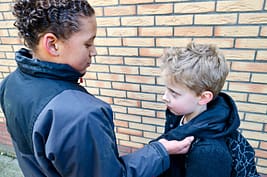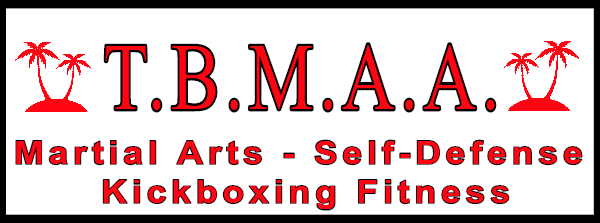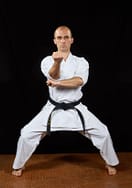Children's
Self-Defense and Martials Arts
Can children really learn to defend themselves? The short answer is yes, but against who? If you have ever had to deal with children, you know they can learn just about anything they set their minds to. This, of course, is with the correct motivation. If you are teaching children self-defense the question becomes “what do you teach them”? Teaching survival self-defense is like giving them a loaded gun. Teaching them to defend against a typical bully is not the same as teaching them to escape the grasp of a stranger. There are several different issues in teaching children to defend themselves. These issues must be addressed whether you are a parent or a martial arts or self-defense instructor.
How Do We Teach Children To Protect Themselves?
Maturity is an issue that self-defense and martial arts instructors must be concerned with. Children like to play around, goof off and have fun. Teaching an eye gouge or a throat strike can be hazardous to the other children they practice with. Of course some children are more mature then others as we all know. So the self-defense techniques that you teach to children should be a first concern. What children can be taught self-defense depends on the maturity of the child or their ability to comprehend the outcome of what they are doing. Some children mature faster than other due to their parents and other environmental factors. The fact still remains that children will be children and they don’t always do as they are told. Many adults have the same problem. This is the reason there is overcrowding in the prisons is immaturity and making bad choices.
To further answer the question, what age should children be taught self-defense depends on the child maturity? I personally teach some basic self-defense skill to children at ages 5 to 12. Most children 12 years and older are big enough to defend themselves against some adults if taught properly. This is always dependent on the ability to focus and understand what they are doing, along with size of the individual. We don’t want to teach emotionally immature young adults to become a more powerful bully. If children can’t control their anger and are being violent toward other children their own age they need psychological counseling first, not self-defense training. These types of children may be the ones your child might have to defend themselves against.
Where do you start when teaching the younger children ages 5 to 11 years of age? Also how do you teach in a way that won’t traumatize them? The first thing is to teach them that there are bad people in the world and not everyone is a good person. Awareness training should be the next part of self-defense training just like you would train an adult. Teaching a child prevention is always the best part of self-defense training. This will carry into adult years if taught properly. Teaching children to use words to diffuse a bad situation is not always easy especially if they are afraid (in a bully situation). It is almost like teaching the adults the value of humility, easy to understand and difficult to do.
Bullies Will Always Be With Us

We all know small and younger children can’t defend themselves against an adult. In my opinion that is a fact. They just don’t have the body mass, strength, and speed to strike hard enough to do and real damage for the most part. The best self-defense to teach them are some techniques to use against school yard bullies. The techniques used against pulling and shoving are the easiest to learn. Children should not have to learn to defend themselves at school but we all know it happens. Most schools in the United States have a “no tolerance” for fighting rule. With that in mind we all have a right to defend ourselves. Any striking taught to children to use against other children should not cause any serious damage. No eye gouging, throat striking and the like. Elementary school yard bulling, most of the time, is not real serious but kids need the confidence and skills to stand up to bullies. Children do not have the same ability to think and analyze the same way an adults do. There is a fine line between a child having to defend themselves with physical violence and walking away or asking for help.
Teach a Child to Get the Needed Attention, and Sometimes Pay Attention
A child defending themselves against and adult is about the child screaming and yelling (kicking, biting, and thrashing about) to “by time” so the responsible adult can take care of the situation. There are things a child can learn to slow down someone trying to abduct them. Anchoring themselves to a solid object while screaming is the most commonly taught child self-defense technique. Latching onto the abductors legs to make it hard for them to run with 40lb child clinging to their leg is another way. These are known techniques a child can learn, of course, with several other escape techniques also. They must be practiced with people other than parents. If practiced with a parent the child may perceive the training as play and fun, which will not help them. Fear or uncertain conditions during training also help for retention of these basic skills. Emotions or feelings help us all store this type of training in long term memory which can be used at a later time if needed. Remember some children are not mature enough for fear training and may panic and become more traumatized during the training.
Conclusion
Children should not have to defends themselves from anyone, but that is not reality. Some older children do get into fights at school or even in their own neighborhood. Self-defense skills do come in handy when another child insists on getting physically aggressive. Of course children need to be taught to control themselves and always do their best not to get into a fight. Most school system in the United States have zero tolerance policy against fighting in school. But don’t tell me a child should not defend themselves against some miscreant who is bent on hitting someone.
The little ones, under 6 years old, should never be left alone with older children or anyone you don’t trust. I am sure we all know this as a fact. Children should be taught properly how to stand up to school yard bullies. Generally, self-confidence is the best way for those situations. On the other hand, children must be taught about stranger awareness and predatory dangers that exist in the world. There are many ways children can slow down the process of being abducted by yelling, screaming, kicking, biting, and anchoring. All adults need to be alert when out in public with their children. Sometime kids just wonder off to whatever grabs their attention. Most anybody can have children but parenting is a tough job. Be a good parent.
Children can be taught age specific self-defense. Most of it seems like common sense and easy to learn. Parents, please watch out for other parents who seem to lack common sense and let the child wonder into unsafe conditions. Kindly say something to them for the children’s sake. Also, find some way to teach your child how to defend themselves if they are forced to.

